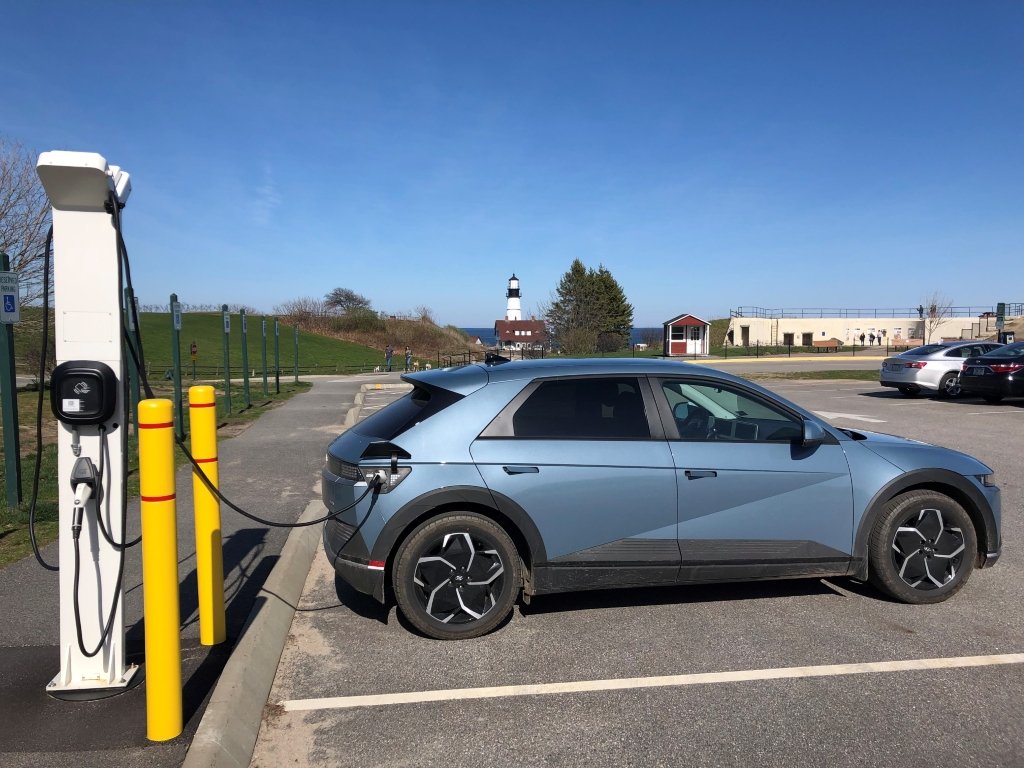Why EVs are more convenient than gas
Some parks, like Fort Williams in Cape Elizabeth, have EV charging. I charged my car there while we were exploring the gardens with friends. PHOTOS: CHUCK HAYWARD
By Chuck Hayward
This claim may surprise you:
EVs are more convenient than gas.
If you’ve read anything on the internet or talked to an EV skeptic, you’ve probably heard the opposite claim—that EVs take forever to charge, and you’ll waste a lot of time sitting at charging stations waiting. Conventional wisdom is that it’s so much easier to just fill up a gas tank and go. It’s time to let you in on the secret that EV drivers know: Charging is far easier and more convenient than gas. Why?
Ask yourself this question: how long does it take your cell phone to charge?
If you’re like most people, you’d probably answer with “I don’t know” because you just put it on the charger at night or during the workday and don’t think about it. The same is true for an electric vehicle 90% of the time or more. If you have access to a charger at home or at work, your EV charging habits will be just like your cell phone charging habits; you’ll plug it in at night or during the day and won’t even think about it.
Can you drive 7,000 miles with only one gas station visit?
If you don’t have access to a charger at those locations, there are a couple of things to keep in mind. Most EVs come with a charging cord that can be plugged into a standard outlet in a garage or driveway. Most Americans drive less than 40 miles a day; a standard outlet can provide enough electricity to recover this in about 8 to 12 hours for most EVs. That’s how long your vehicle will probably sit in your driveway or garage each night. Many people find that the included Level 1 charging cord is plenty for their driving habits and never even need to have an electrician install a faster Level 2 charging station.
If charging at home is not an option for you, there are charging opportunities all around. Maine already has more than 500 public charging sites with over 1,200 ports available. Maybe your workplace has them. Maybe the grocery store has one that you could use when you do your shopping. Maybe there is a Level 2 charger close enough that you could park overnight when you need to. A friend of mine struggled unsuccessfully for a couple of years to get her condo board to put in EV chargers. She finally got an EV after the elementary school across the street put in chargers that are available to the public at night. She uses those about once a week and it’s as easy for her as charging at home.
There are lots of options for charging when your car is parked for long periods. But that’s not always possible, and there are times you must sit and wait at a fast charger. Even the fastest EV chargers still take 20 minutes or more.
How many times have you been out on a quick errand when you notice your low fuel light is on? So, you spend about five minutes stopping at a gas station to fill up. No big deal. It’s easy to add a quick fill up into your routine. It sounds pretty inconvenient to have to wait 20 minutes or more to charge an EV instead.
If you started every day with a full tank of gas, how often would you go to the gas station?
If you can charge an EV at home, at work, or at the grocery store, it’s already worked into your routine. You don’t have to go out of your way to charge it. You only end up going to charging stations and waiting when you do multi-hour drives. If you don’t do long drives like this very often, an EV could be more convenient for you. It’s easy to do your own research:
Step one: Pick an EV that appeals to you for whatever reason. Try to avoid choosing based on the highest range or fastest charging speed. (Even though that’s what the manufacturers tend to highlight, these things don’t matter much in the dayto- day of owning an EV.)
I generated this map for my EV on a very cold day in January. In the summer, the range is 20-30% larger.
Step two: Go to EVNavigation.com. Enter your location. Then, on the menus, select the vehicle you picked.
The software will generate a map with two bubbles for the EV you picked. Anywhere in the light-colored bubble, you can get there and back without charging. Anywhere in the outer, dark-colored bubble, you can get there on a single charge, but you’ll need to charge to get back to your starting point. If you don’t go outside of those bubbles very often, the EV you picked should work just fine for you.
This is the map for my car from my home near Portland. This means that if I start my day with a full charge in my driveway, I could get to Boston and back without having to charge. I’ve done it! Or I could take a weekend trip to Newport, R.I. If I charge overnight at the hotel while sleeping, I can get back home without charging. I’ve done this, too! This is great for a single drive, but a truly amazing thing happens when you can charge at home or work day after day; you almost never have to go to a station just to charge.
Last summer, I drove about 7,000 miles in four months. There was only one day where I drove more than 100% of my battery range and had to stop and charge during a long drive. All my other charging was done at home while my EV was sitting in the driveway. On a couple of trips that were a bit further from home, I arrived without stopping, charged at my overnight accommodations while I slept, then got back home without stopping again.
That means that over an entire summer there was only one day when I absolutely had to go to a charging station and wait. One 18-minute stop to charge all summer! And it was on a long trip, so that 18-minute stop wasn’t even wasted. We used the restroom and picked up lunch, then left when we got back to the car. We didn’t even wait for a full charge: what we got while we took a break was more than enough to get home.
If I had a gas car instead, I would have had to stop at a station about 20 times throughout the summer. And every time, I would have been standing outside next to the pump and waiting. I’ll gladly trade one 18-minute charge while I get lunch for 20 fiveminute gas fill-ups where I have to stand at the pump waiting.
After the summer, I didn’t need to stop to charge again until we drove to New York City for Thanksgiving. That’s another three months without ever waiting to charge. Now do you agree with me that EVs are more convenient than gas?
My summer travels. The one long drive back from Connecticut was my only charging stop all summer. Otherwise, I charged at home or my overnight destinations.
I was able to charge my car while exploring the gardens at Fort Williams with friends. PHOTOS: CHUCK HAYWARD
This article appeared in the Spring 2025 edition of Green & Healthy Maine HOMES. Subscribe today!
Find Maine experts that specialize in healthy, efficient homes in the Green Homes Business Directory.




